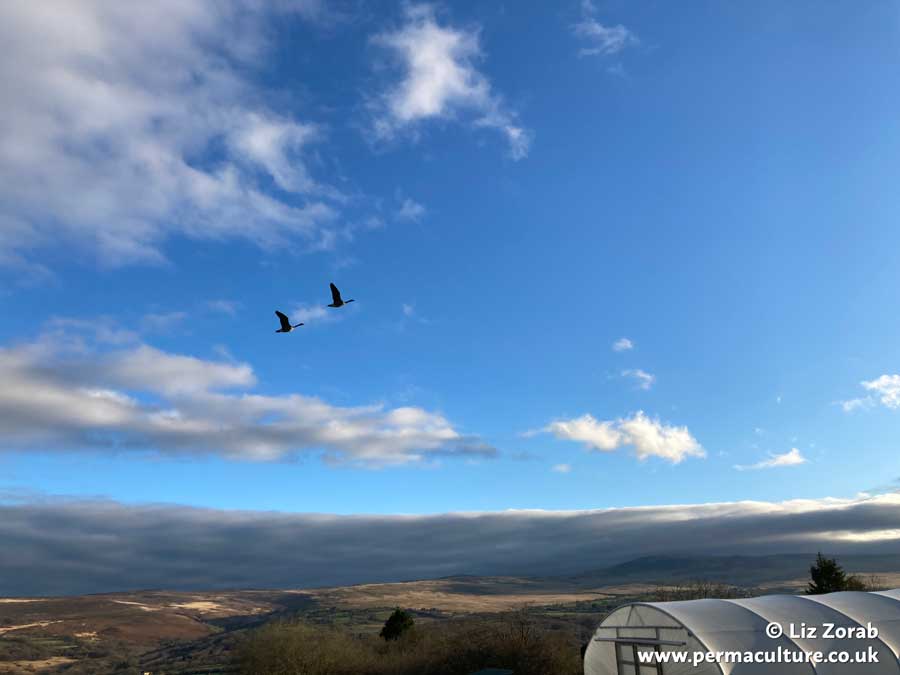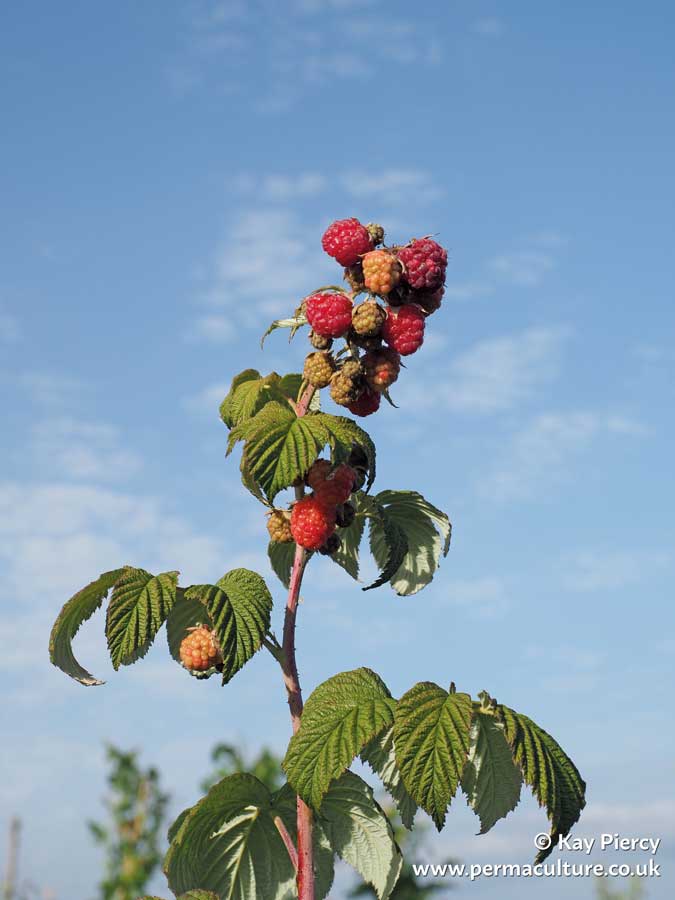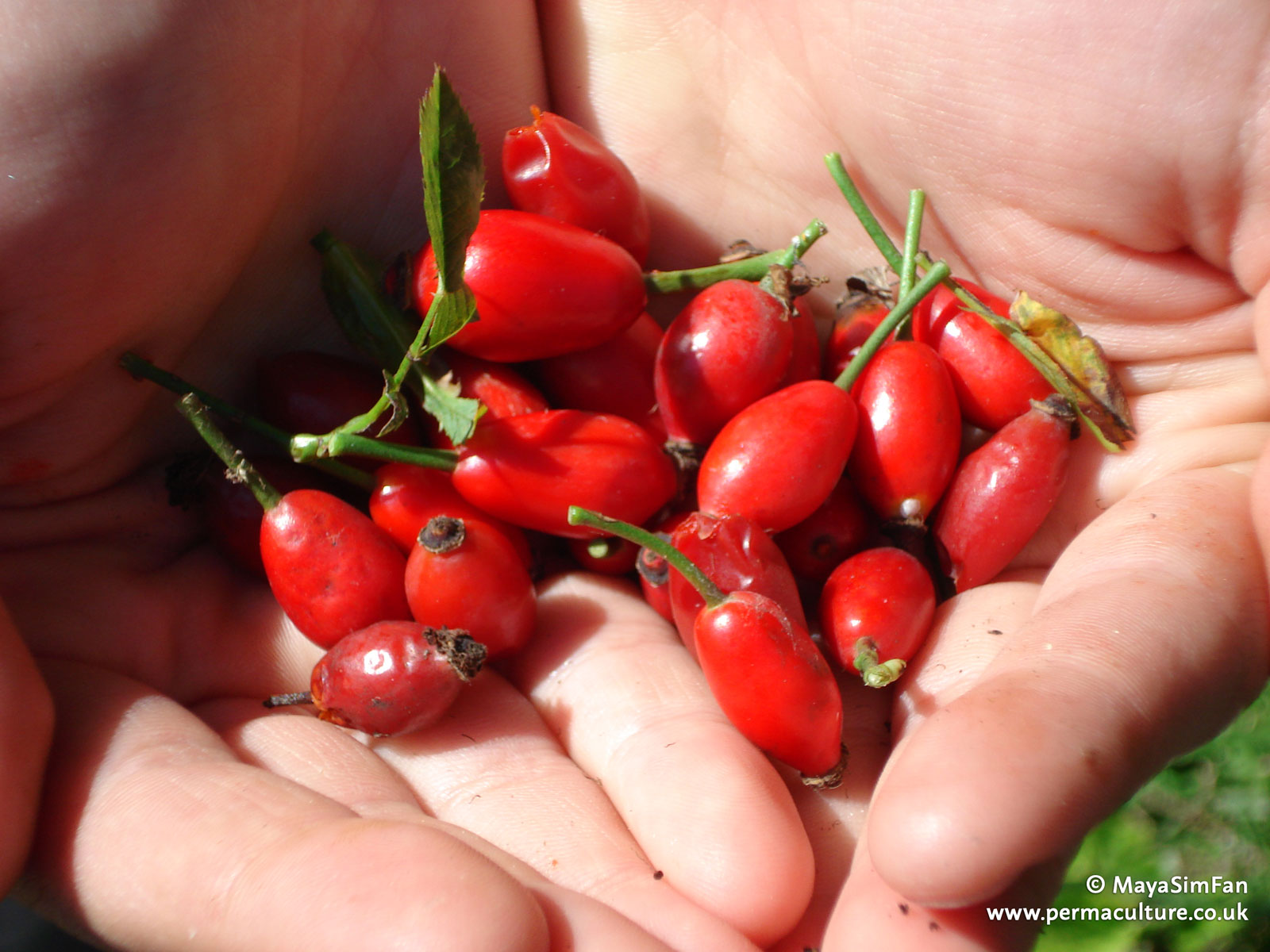This permaculture design for managing grief and anxiety arose unexpectedly to meet a personal, emotional need. The General Election result of 2019 left me with feelings of despair that were compounded by grief for our planet. Shortly after I began this design process, my mum was diagnosed and treated for cancer. As she healed, the Covid-19 virus took hold of the country and significantly changed the way we lived. This was an unintentionally well-timed design!
I used the land-based design process SADIM: Survey, Assess, Design, Implement and Maintain. The simple five step process allowed me to work through the varied emotional threads of my inner landscape and weave them together in a way that began to make things clearer.
I then used De Bono’s ‘Six Thinking Hats’ to guide me. I enjoyed the process of getting to know the hats and their meanings.
The White Hat – calls for information known or needed. ‘The facts, just the facts.’
The Yellow Hat – brightness, optimism, the positives and benefits. Risks, difficulties, problems – spot difficulties where things might go wrong, why something may not work.
The Red Hat – signifies feelings, hunches and intuition. Express emotions and feelings and share fears, likes, dislikes, loves, and hates.
The Green Hat – creativity; possibilities, alternatives, and new ideas. An opportunity to express new concepts and new perceptions.
The Blue Hat – manage the thinking process. It’s the control mechanism that ensures the Six Thinking Hats guidelines are observed.
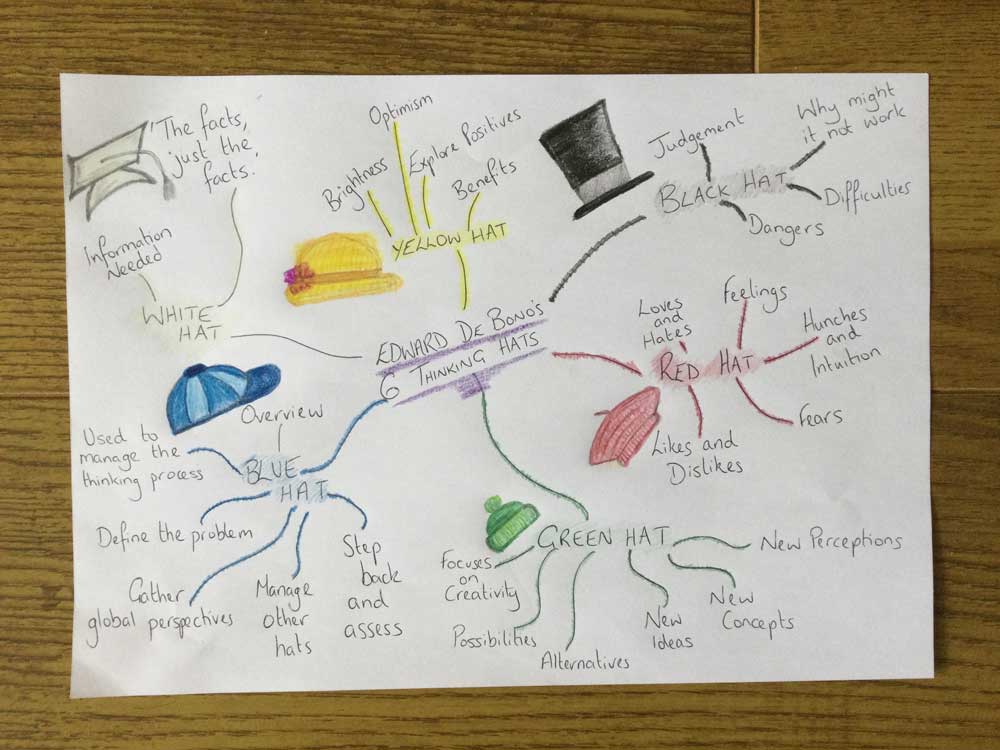
I very much started the design with Black and Red Hat thinking and was able to design my way through to more Yellow, Green and Blue Hat thinking. You will see some of the ways I used the hats mentioned throughout.
I started by putting my metaphorical Blue Hat on for an overview; I needed to pause and be fully present with what was happening and how I was feeling about it. I needed to observe past patterns that were similar to how I was currently feeling. I needed to stop and interact with my emotions, not just ‘keep on, keepin’ on’. I realised that I spent a lot of time looking after my family’s health and wellbeing, this design reminded me to support my own right to good mental health.
I put the Green Hat on to encourage myself to think about possible alternatives and so, inspired by Rob Hopkins’ ‘From What Is to What If’ I asked myself:
What if I had a plan to maintain positivity and hope?
What if I had a plan to take proactive, pragmatic steps to create the kind of world I want to live in?
These were two big questions and so I decided to divide them into separate designs.
Tentatively putting on the Red Hat, I allowed myself to sink deep into my feelings; similar to meditation I allowed the thoughts and emotions to pass through me so as I could observe and identify them. By naming them I could better understand them. I felt stuck and in despair. I felt angry and hopeless. I was annoyed and heartbroken. I feared for the country and for the Planet. I feared for my children and the generations who would come after. I was afraid for those who are most vulnerable in our country and across the world.
Once I had acknowledged my feelings I needed to take the dysfunctional energies of fear and despair and transform them into awareness and action. By trying on the Blue Hat I could define the problem and my conclusion was that we cannot wait for governments to take the lead. Change always starts with the people. To benefit my mental wellbeing I needed to feel like I was doing something.
I started to answer my question with White Hat thinking, by looking at facts and information about myself. During two periods of my life I found a way to overcome depression and high blood pressure. I chose to do this without prescribed medication1 and found alternative ways to improve my mental health and physical wellbeing. Since then, for the last 20 years, I have weathered stress and anxiety using techniques that suited me.
I had always applied the permaculture principle ‘Each important function is supported by many elements’ the function was maintaining my mental wellbeing and it had been supported in the past by a variety of elements. Putting on my Green Hat I recorded all the things that I knew had helped me in the past.
But how often was I really doing these things? Gathering the facts in a White Hat way I made a simple graph; from this it was a shock to see that in reality I wasn’t doing many of them per week, some none at all. I had activities that could be helping me but I wasn’t actually doing any of them regularly.
I then analysed the positives and negatives of each activity or element plus their potential in the future. By doing this I hoped to understand which elements would benefit me most and that I should take time to increase them in my daily habits.
For example, see table at the end.
With my optimistic Yellow Hat on I knew I had lots of tried and tested methods of maintaining my wellbeing. While reviewing the elements I found that a recurring theme for me was prioritising these things in my week. A potential idea was emerging; maybe I could make a schedule which included not just the usual Home Ed plans, family appointments etc. but also the things I needed to do.
I acknowledged I’d let a lot of the elements slip and difficulties had arisen from this. I went through the list with my Black Hat on, marking the ones I wasn’t doing, 12 out of 15 were not happening on a regular basis. I really had not realised how much I had stopped doing. No wonder I was struggling to feel motivated but now wearing the Red Hat I could see I had the hope of things that could help.
It was time for some Blue Hat thinking – I needed to make a plan. I always use my diary to schedule things and make sure they happen. Looking back through it I could see that I rarely wrote things for me personally.
Using post-its and my planner I attempted to schedule all of my beneficial elements.
I had a diversity of elements, all easily achievable, requiring no specialist equipment, using things that we already had. I realised these many elements could be configured in different ways at different times e.g walking the dogs through nature.
I decided it would be good to monitor how it was going. I wondered if I could include it as part of my nightly gratitude journal routine but I also wanted to include diploma and permaculture living check-ins. I spent some time Wild Designing, sketching up different ideas and planner page configurations, and decided I would order a plain notebook or bulletproof journal for write-ups.
I came across a planner that could meet my needs and used the following permaculture principles:
Small scale intensive system – all the information contained in one small system, better than having lots of different books or places to record the different elements. A stacking tool.
Catch and store energy – by having all my information in one place, I can catch my ideas, plans, my gratitude and good habits, store them to look over and use them as momentum to fuel self-care needs and goal planning.
Obtain a yield – I love the written word and will enjoy the yield of seeing the pages filled. Having my goals and habits written down week-to-week will hold me accountable and encourage me to support myself by doing them.
I am now using the planner for my self-care needs and have incorporated Home Ed, DIY and coppicing schedules and keeping track of everyone’s appointments. One tool meeting all our family needs, a full overview, the perfect Blue Hat tool.
Since having the planner I have gone from zero yoga to, on average, yoga and meditation at least three times a week. I write my gratitudes daily. I garden at least three times a week and have time out in nature, either a walk or time in a sit spot, three to four times a week. We have progressed some DIY and gardening jobs, such as getting the herb garden done, fixing bookshelves and maintaining our green roof.
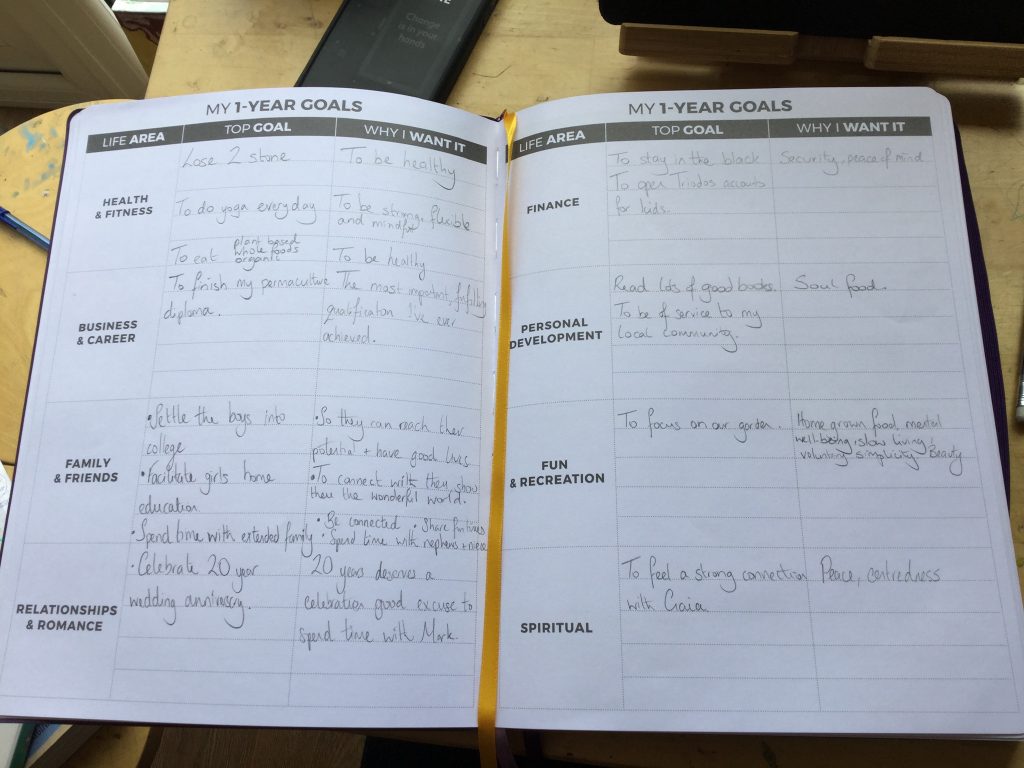
People Care – if I am not mentally strong then I can not give my family and community the care and attention they need.
Fair Shares – improving my wellbeing helps me improve the wellbeing of those around me. When my cup is full, I can and do fill others’. The whole family is feeling more positive and enabled.
I use the ‘My 3-Month Goals’ section in my planner to maintain momentum by choosing three things to attempt to accomplish, reflecting on why I want to do them and making a mini-design to achieve them. In the ‘Monthly Review’ section I can reflect on things that are going well, challenges, lessons I’ve learnt and plan goals and actions for the next month.
For my Permaculture Diploma, I designed an ‘Action Learning Pathway’ that enabled me to record my motivations not only for the diploma but also for life in general. The Pathway contains long-term aims and space to plan and reflect on the steps already taken. I choose to review my Action Learning Pathway annually at Imbolc, to monitor overall yearly progress and to create visions for the year ahead.
With positive Yellow Hat thinking I can reflect that I’m on my fourth planner and I use it every day. The benefits are that each week I can see everything that’s happening on one double-page spread. I love the Habits/Skills checker; I find it motivating instead of a pressure. I can review the week, what actions I’ve ticked off and record my gratitudes. I make plans for the following weeks. I record many things in the Visions pages including goals and implementation plans from my Permaculture Designs.
It is now an ingrained part of my days and has helped me stay on top of things and not feel overwhelmed. Most importantly it helps me to track my habits and make sure I am doing the things that I know improve my mental wellbeing. I have been able to create a design for taking pragmatic steps towards the kind of world I want to live in and now have the energy to plan, lead and engage with community projects. This design2 has enabled me to process my grief, pause and move on with more positivity and hope.
1 Always consult with your health care practitioner first.
2 The full design is available in the Diploma Design Archive on the Permaculture Association Website.
Emma Leaf-Grimshaw is Heartwood Hearth – Permaculture Living and Design
Instagram @earthlovingfamily
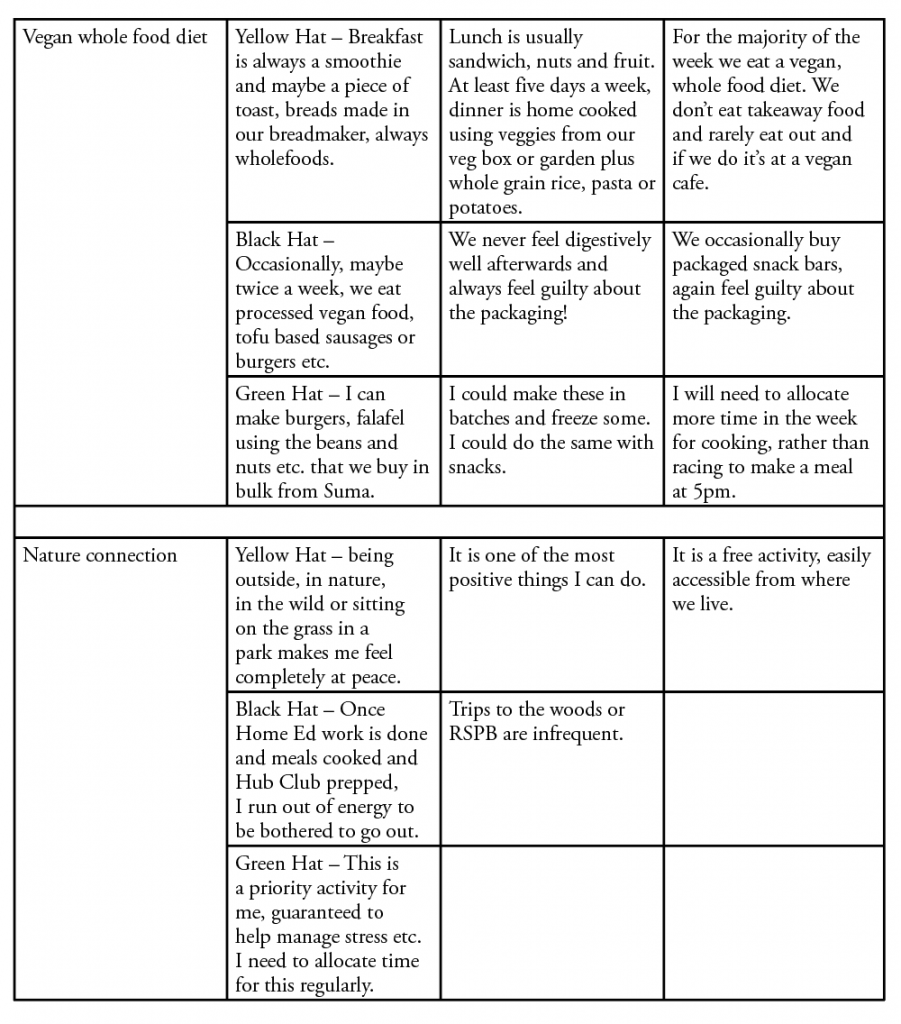
Emma is featured PM100, with her permaculture design for an ethical wardrobe. Read more HERE.
